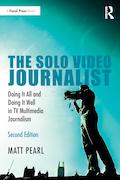I used to be an anomaly.
When I arrived in the 10th-largest market in the country, I was one of the few who worked as a solo video journalist – or a reporter who shoots and edits my own stories. There were maybe a handful of us, and the newsroom wasn’t geared towards our interests.
More than a decade later, the state of my newsroom – and most others – has been upended.
According to the latest RTDNA survey, more than 90% of local TV newsrooms use solo video journalists – or multimedia journalists, or MMJs. More than half of newsrooms in market 51 or lower use “mostly” MMJs, and four out of five newsrooms in Top 25 markets use them in some way. Soloists are no longer a position of the future; we are present across the board in local news, and we’re finding opportunities beyond broadcast as well.
But for a long time, no book existed that offered a comprehensive overview of the position and gave instructions and advice specifically designed for it.
That’s why I wrote one.
Four years ago, I announced the release of The Solo Video Journalist, which featured interviews with nearly a dozen MMJs and broke down every step of the solo storytelling process, from shooting to interviewing to writing to editing.
Today I’m thrilled to announce The Solo Video Journalist, 2nd Edition, with more interviews, significant updates, and advice tailored to the updated landscape of video journalism.
The core of the book hasn’t changed. My intent has always been to empower one-person crews with the types of insights, techniques, and advice they rarely receive organically – and that I rarely received during my formative years in the field. Many journalism schools teach the foundations of reporting, and that’s excellent and necessary. But they fail to dive deep into the realities of working alone: the emotional stress, the time management necessities, and the simple logistical questions of how to perform two traditional jobs with only one set of hands. Aspiring journalists are left to figure it out on their own, often on the fly in the pressure cooker of their first jobs. My book offers a much-needed shortcut: a one-stop how-to guide for every element of producing a story.
But this new edition goes further. Much has changed since the original text was published, and The Solo Video Journalist, 2nd Edition adapts to that:
- I have completely revamped and expanded the section about online and social media, geared toward thriving in the digital world while still excelling on the air.
- I have added several chapters called “Career Chronicles,” which cover the increasing options for solo video journalists beyond the traditional paths in broadcast news.
- I have updated the guidance to adapt to many of the changes in equipment over the last half-decade, namely the rise of phone and DSLR/mirrorless cameras.
- I have included The MMJ Survey, in which nearly 100 soloists describe what they love – and don’t love – about the job
Most importantly, I have filled these pages with some of the most talented soloists – or one-time soloists – in the industry. You’ll hear from:
- Jon Shirek of WXIA-TV on preparation and time management
- Heidi Wigdahl of KARE-TV on dressing for the dual roles of the job
- Greg Bledsoe of KNSD-TV on developing a system for one’s gear
- Neima Abdulahi, culture reporter, and Tiffany Liou of WFAA-TV on dominating online
- Anne Herbst of KUSA-TV on shooting video and B-roll
- Mitch Pittman of Side Road Media on shooting interviews
- Joe Little of KNSD-TV on shooting stand-ups
- Ted Land of KING-TV on logging and writing
- Forrest Sanders of WSMV-TV on editing
- Blayne Alexander of NBC News and Emily Kassie of the Marshall Project on rising from soloist roles to more traditional jobs
- Sarah Blake Morgan of the Associated Press and Dougal Shaw of the BBC on finding atypical lanes in solo video journalism
- Peter Rosen of KSL-TV on becoming an MMJ midway through his career
- Paige Pauroso of WBTV on staying safe while working alone
And, as with the original, I’m honored that the legendary Boyd Huppert of KARE-TV contributed the foreword – and offered insights in a chapter labeled, “Learning from the Best.”
I am beyond excited that this 2nd Edition is available because I believe in its power. I received this opportunity because the original sold far beyond my publisher’s expectations – a clear nod to its necessity for aspiring storytellers in a demanding field. As solo video journalists continue to populate newsrooms nationwide – and dominate in terms of awards, assignments, and opportunities – we must continue to cultivate the talented, versatile, and ambitious individuals who take on these positions.
I am no longer an anomaly. And that’s a beautiful thing.
The Solo Video Journalist is available for purchase. You can find it on Amazon, Barnes & Noble, and the publisher’s web site.
Matt Pearl is the author of the Telling the Story blog and podcast. Feel free to comment below or e-mail Matt at matt@tellingthestoryblog.com. You can also follow Matt on Facebook and Twitter.

